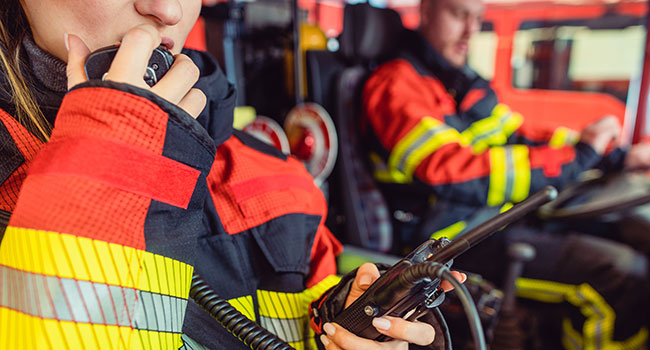
An Uninterrupted Lifeline
Radio communications link emergency responders to enhanced systems
- By Mahesh Nanjakla
- Oct 01, 2021
For a first responder rushing
into a building emergency,
losing communication with
their teams inside or outside
of the building can be
terrifying. In fact, according to an IAFC
(International Association of Fire Chiefs)
2017 survey by Safer Buildings Coalition,
94% of surveyed first responders say
reliable in-building communications is
critical or frequently important during
emergencies.1,2
Yet, 98.5% report dead spots in
buildings, and 56% have experienced
a communications failure over the last
two-year period.1,2 These dead spots and
failures not only impact communication
but directly affect first responders’
safety and, ultimately, the safety of the
individuals they’re trying to help—as on
9/11, when firefighters and police officers
could not properly communicate with
each other in the World Trade Center.
POOR SIGNAL STRENGTH
Dead spots within a building for first
responder radio communications are
caused by poor signal strength, which is
impacted by several factors depending
on the facility. Low-emissivity glass
windows designed to block solar heat
can weaken radio signals into and out of
buildings. While underground structures,
obstructions (such as other large nearby
buildings), and building materials, like
concrete or metal, can all affect signal
strength at a particular location.
Radio communication outages can
be avoided for first responders within a
building, who might be in a dire situation.
Thanks to technology like emergency
responder communications-enhancement
systems or bi-directional amplifier (BDA)
systems, first responders can walk into a
building with confidence that their support
teams still have their backs.
BDAs are signal boosters that
sustain two-way radio communications
throughout a facility—even in stairwells,
underground tunnels and other typically
challenging spaces. A BDA can provide
100% in-building coverage by boosting
signals from a public safety radio repeater
and distributing them throughout the
building using the Distributed Antenna
System (DAS). The BDA receives and
amplifies transmissions from radios inside
to the repeater antenna outside and vice
versa, safeguarding reliable two-way
communications.
IMPROVING CODE
As a direct result of the World Trade
Center disaster in 2001, the National
Institute of Standards and Technology
(NIST) published recommendations in
2011 to improve code and public safety.
Included was a recommendation to
update national fire codes to provide
reliable radio coverage in buildings. Most
current adopted fire and building codes
require emergency responder radiosignal
strength, and coverage measured
in all new and some existing construction.
The International Fire Code (IFC) has
been adopted by many states, requires
acceptable signal coverage throughout 95%
of the building in all areas on each floor
in new buildings, while the National Fire
Protection Association (NFPA) requires
99% building coverage in critical areas and
90% in general areas.3 Meeting these code
requirements can help prevent delays in
acquiring a Certificate of Occupancy from
Authorities Having Jurisdiction (AHJs),
such as a fire marshal, once construction
is complete on a new facility.
Deploying a BDA system not only
supports compliance but also helps protect
first responders and makes their job easier.
It is important to check the specs though.
Not all systems comply with Underwriters
Laboratory (UL) code UL 2524. The UL
product listing creates a performance
standard for ERCES/BDA systems and
assures AHJs, architects and engineers
that the system works the first time and
every time in accordance with IFC and
NFPA regulations.
Every second counts in an emergency,
and a communication failure can put
lives at risk. Installing a BDA system that
meets all applicable codes can help keep
occupants safe while also protecting
rst
responders who are putting their own lives
on the line.
This article originally appeared in the September / October 2021 issue of Security Today.
About the Author
Mahesh Nanjakla is the offering management lead, Emergency Responder Communication Enhancement Systems (ERCES), Honeywell Fire Systems